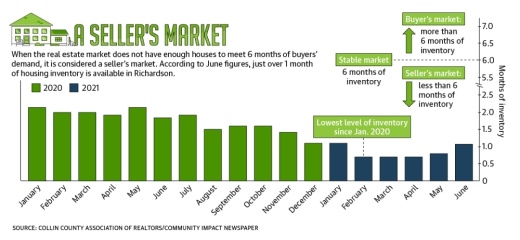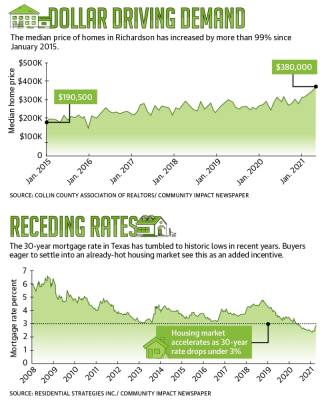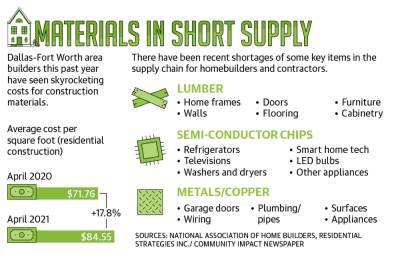“We are seeing inventory levels at a 50-year low,” said Marvin Jolly, chairman of real estate advocacy group Texas Realtors. “It’s not just perception—it’s reality.”
As of June, there was 1.1 months worth of housing inventory in Richardson, down from 1.8 months in June 2020, according to data provided by Collin County Association of Realtors. A stable market is one that has 6 months worth of homes on the market, according to the Texas Real Estate Research Center.
A lack of supply and rapid pace of sales are behind the surge in home costs in Richardson and beyond, said Chris Kelly, president and CEO of Ebby Halliday. June data lists the median sales price in Richardson as $380,000, an increase of 16.7% year over year.
“The $1 million price point has been on fire—anything above that has been selling at an accelerated pace—but when it comes to someone looking to buy in the [two- and three-hundred-thousand dollar price range], that is a very difficult property to find right now,” Kelly said.
Despite these challenges, real estate experts hold out hope that inventory levels will go up as seller confidence is restored and issues around the building supply chain are resolved.
“We do expect the market to slow down,” said Jim Gaines, an economist with the Texas Real Estate Research Center. “The dominoes have to fall in the right order and at the right time—and that’s being disrupted a little bit.”
Effect on first-time homebuyers
High levels of demand mean most homes are selling for above asking price. But the bank will only approve a loan for what a home is worth, said Lisa-Marie Thompson, a loan officer with Primary Residential Mortgage Inc., which has offices across the metroplex.
Many first-time homebuyers don’t have the cash on hand to make up the difference, Thompson said.
“This isn’t a market that is feasible for them,” she said. “It’s almost impossible.”
As a result, millennials and other first-time homebuyers are leaving inner-ring suburbs like Plano and Richardson and moving to less populated nearby counties—such as Grayson, Kaufman, Hill, Parker and Ellis—that have a greater supply of homes at lower price points, Kelly said.
“We are seeing sales growth in those counties, sometimes 30% to 40% year-over-year,” he said. “Part of the reason is that when you get out to those areas, the affordability starts to come down again.”
Skyrocketing prices are not the only thing preventing first-time homebuyers from entering the market. Baby boomers and other older residents are aging in place, which is curtailing resale inventory, Kelly said.
“What we have found is that people are living longer, they’re healthier, and they’re staying in their homes longer,” Kelly said. “So there wasn’t this natural migration out of homes ... that would have created a supply as millennials grew into the homebuying age.”’
The prevalence of investors buying single-family homes as rental properties is also responsible for low levels of supply, Jolly said, noting he estimates 30% of buyers in the metroplex are investors.
“A lot of them have a very, very high level of cash,” he said. “So, they’re putting either 50% down or in some cases 100% cash down.”
Jolly said his association is working with the National Association of Realtors and state legislators to enact policies that would alleviate affordability and supply issues. One strategy would be to ease loan restrictions around paying above-asking prices.
“Buyers that are using FHA loans or VA loans cannot pay above appraisal price—it is actually illegal for them to attempt to do that,” Jolly said. “The federal documentation does not support the current market we are in.”
Winning the bid
Buyers able to afford Richardson listings have to get creative to win the bidding war. One approach is to offer a full or partial appraisal waiver, said Susan Kassen, a Richardson-based Realtor with Ebby Halliday.
“On almost every single offer that I write, I have some sort of appraisal waiver,” Kassen said of the strategy, which waives the buyer’s right to terminate the contract due to an appraisal. “Before January, I’d probably only use an appraisal waiver once or twice a year.”
Waiving an appraisal can be risky because it locks the buyer into the purchase price of the home, even if it is worth much less, Thompson said. It may also disqualify the buyer from their loan, she added.
“A lot of times, customers are just signing a document without understanding what it really means,” she said. “What happens is they buy a house for $400,000, it appraises for $360,000, and oops, all of the sudden, they don’t have the $40,000. You lose your earnest money and your option money.”
Angela McCants, a Richardson-based Realtor with Dave Perry Miller, said she has seen an uptick in buyers unable to close on homes due to last-minute financing issues.
“You’re seeing a lot of houses going back out on the market,” she said. “Buyers really need to be careful because they end up losing a lot of money.”
Land and supply chain issues
Despite a lack of available space, interest from builders in Richardson persists. The city is 96% built-out, according to Richardson city officials.
Driven by demand, developers are increasingly looking at less conventional routes to new homes. That may include converting commercial zoning to residential, Jolly said.
“There is a lot of office space that is vacant, and it may stay vacant for a long time as the workforce moves virtually,” he said.
Of course, even where there is available land, disruptions to the supply chain have further complicated the job for homebuilders.
According to the National Association of Home Builders, aggregate construction material costs are up 12% year-over-year, and lumber costs have increased by as much as 300% since last April.
And while contractors have had to deal with shortages and price spikes in the past, it is often just with one item at any given time. There are documented issues with lumber, metals and semiconductor chips, among other materials.
Taken together, land and supply chain challenges are helping to drive prices up. NAHB data suggests recent material cost increases have raised the price of a new single-family home by $36,000 over the past 12 months.
What the future holds
Experts do not predict a crash similar to what was experienced following the 2008 housing crisis. National statistics from the Mortgage Bankers Association indicate lenders are being more restrictive, according to Gaines.
“[Mortgage] lending has not been excessive,” he said. “[Lenders are] requiring a higher FICO score, a lower debt-to-income ratio, and, in many cases, a higher down payment.”
Interest rates have increased slightly since plummeting to historic lows at the beginning of the pandemic, Thompson said. But they continue to remain optimal for potential homebuyers looking to secure a low monthly payment.
This, coupled with the fact that North Texas is a highly desirable place to live, means the Richardson market could continue to fire on all cylinders for the foreseeable future, he said.
Steven Ryzewski contributed to this report.







